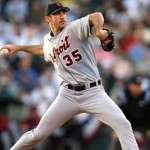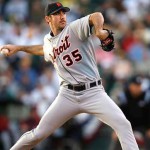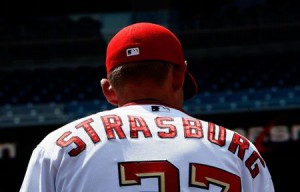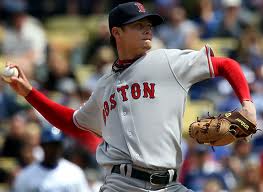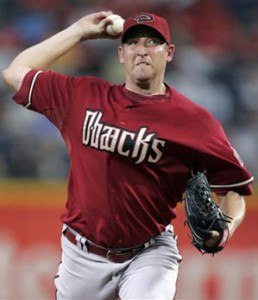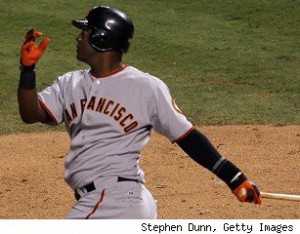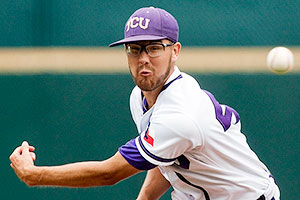
Will Matt Purke fulfil his former Ace-starter promise? Photo AP/Nati Harnik
Its nearly impossible to project high-end pitching prospects, the further they are from the minors. Think of someone like Colten Willems, our #1 draft pick in 2006 who retired before ever getting out of high-A. Or perhaps Josh Smoker, a supplemental 1st rounder in 2007 who struggled with injury and is now a situational lefty in the high-A bullpen, four-plus years into his pro career.
But, it is fun to think about the upper-end, best case scenario and what it would mean for this team. I’m sure that this post will garner a ton of disagreement; feel free to make your case in the comments pro or against what i’ve posted. I know that some people are already drinking the kool-aid on September call-ups Peacock and Milone, but I’m not (read below for more). I’ve included all our current starters and most of the upper-end draftees over the past few years.
(post-publishing note: a commenter asked what I “meant” by a #1 or a #5 starter. Here’s text pulled from the comments as to how i’m defining each of these level of starters:)
- #1 starter is one of the best 15-20 pitchers in the league, someone who you’re genuinely surprised if he performs badly on a given day, mentioned in Cy Young conversations. Verlander, Lincecum, Halladay.
- #2 starter: a slight step down from your elite, but still a reliable starter. The “robin” to the ace’s “batman.” I’m thinking Matt Cain, Chad Billingsly, Cole Hamels, Clay Buchholz as examples. Not the best guy on their rotation but a great #2 guy.
- #3: better than your league average pitcher, someone who is solid, consistent innings eater and who routinely gives you quality starts but not much more than that. I’m thinking someone like a Jonathan Sanchez, Derek Holland, Edwin Jackson, someone like that.
- #4: is basically someone defined as someone who’s a slight step above the back-of-the-rotation guy, a mlb veteran guy who knows how to pitch but doesn’t have the best stuff to really go much beyond. John Lannan is a great example of a #4 starter. Freddie Garcia, John Lackey, Jon Garland, Jason Marquis are other examples.
- #5: just good enough to fill out your rotation. Starters at the back end who all you’re hoping for is 6 innings and keeping your team in the game. On our team, Livan Hernandez, Tom Gorzelanny, Craig Stammen in past years.
Nationals Starter prospect Ceilings (per scouting reports, personal observations)
#1: Strasburg
#2: Zimmermann, Cole
#3: Purke
#4: Lannan, Ray
#5: Detwiler, Turnbull, Solis
4-A starter: Milone, Meyers, Rosenbaum
MLB bullpen: Meyer, Peacock, Stammen
Minors starter: Maya, Martis, McGeary, Jordan, Grace
Minors bullpen: Holder, Smoker
Discussion.
#1 Starters: Stephen Strasburg, in my mind, is already an “Ace” starter in this league, ranking up among the 15-20 best arms out there. When he’s healthy. In 2010 he posted MLB-best k/9 rates and would have clearly led the league in some sabremetric measures of pitching in his debut season had he qualified. But health is the big question mark; is he going to become the next Justin Verlander or the next Mark Prior? Only time will tell.
#2 Starters: Jordan Zimmermann has achieved Robin to Strasburg’s Batman in this rotation, and seems set to be a pretty good rotational guy for the next few years. AJ Cole pitched well in his first full season, is a big kid who was touching 96 in HS. He could be a big arm who slides into the rotation as a dominant arm. Some think his ceiling is even higher than a #2 starter.
#3 Starters: Matt Purke was a 1-1 talent (1st round, 1st overall draft pick) before suffering shoulder bursitis, and the Nats took a gamble on him. But its a great gamble; he has Ace material, throwing mid 90s from the left hand side with completely dominating stuff. He was rated BA’s #14 prospect coming out of high school and had a $4M signing bonus deal turned down by MLB. He allowed the Nats medical staff to do a dye-injection MRI and were satisfied with the results. His deal could be remembered as a steal of the 2011 draft if he pans out. However recent scouting reports have listed his stuff as “ordinary,” so a #3 starter seems like a good middle ground for now. If his arm is really ok, he’ll start to show it next spring (hopefully at high-A) and he’ll rocket up the prospect lists soon enough.
#4 Starters: Perhaps one could argue that John Lannan is a #3 starter but I don’t believe so; I think he’s a solid, underrated #4 starter on a decent rotation. If you compare Lannan to the #4 starters on a number of teams, he compares favorably, and you’d clearly take Lannan if given the choice. The problem is; he’s just not flashy. We’ll never get appropriate trade value for him because his W/L numbers are mediocre and his K/9 rate isn’t that impressive. I’d guess that he sticks in our rotation until he reaches free agency, at which point its likely that some of our developing power arms will be ready to take over. Robbie Ray had a fantastic debut season and may even be better than a #4 ceiling; certainly he put up as good of numbers as his 2010 draft classmate AJ Cole, but his stuff doesn’t project as highly.
Here’s where a number of arguments are probably to be had, starting at the #5 ceiling.
#5 Starters: Ross Detwiler really has yet to fully show his full capabilities, but lefties that throw mid 90s don’t grow on trees. 2012 is a make or break year for him with this organization, and it wouldn’t surprise me to see him moved in the off-season so that the team doesn’t have to deal with his option status when constructing the rotation next spring. I put him with slightly better stuff than the 4-A guys below. I’m still not sold on him as a MLB starter, but saw a lot out of him this season that shows improvement over where he was in the organization in 2010. 2011 draftee Kylin Turnbull was overshadowed by the high-end talents drafted ahead of him, but he’s lefty, throws well and is projectionable. Thanks to Sean Hogan‘s excellent draft research, some scouting reports are here. Right now it sounds to me like Turnbull has a bit more power than someone like Milone and perhaps can get more missed bats. For now i’m listing him as a #5 starter ceiling; if he was a righty he’d probably be in the MLB bullpen category. Lastly Sammy Solis projects thus far as somewhere between a a #3 range starter, a mid rotation guy who has 3 plus pitches and can be a lefty work horse out of the rotation and a back-of-the bullpen guy with mediocre stuff but good constitution. He may not have the best stuff, but being lefty and being a solid, Mark Buehrle build could mean he’s a slightly better version of John Lannan for this team. We’ll see how he does in AA in 2012.
4-A starters: (for those that don’t know what is meant by “4-A or AAAA,” it means someone who is better than a AAA pitcher but not quite good enough to get out major league hitters on a consistent basis). Tommy Milone had a great September debut and has impeccable control in the minors, but I don’t see him having good enough stuff to consistently get major league hitters out. Now, I could be wrong and he could have Greg Maddux-esque control, at which point he doesn’t need mid-90s heat. But from what I saw in his September starts, I don’t think he’s got what it takes to stick in the majors. Brad Meyers could end up in the same position as Milone; a guy who dominates in the minors but who can’t cut in the majors. It doesn’t look like he’ll even get a shot at the 2012 rotation with the crowded 40-man roster. Lastly Denny Rosenbaum seems cut from the same cloth as Milone; a softer-tossing lefty without great K/9 rates in the low minors but who is effective enough at getting guys out.
Bound for the bullpen (but good enough to stick in the majors): 2011 draftee Alex Meyer is going to go one way or the other: he’s either going to be a wild man out of the bullpen or a near #1 starter. Scouts seem to be pretty split as to which way he’s going to go. Right now, based on the struggles he had early in his college career, I’m guessing he struggles to maintain his forward momentum and ends up a Cole Kimball-esque hard throwing option out of the pen. Meanwhile, what to make of Brad Peacock? I know he just finished off a fantastic minor league season and had two effective September starts (giving up just one run in 12 innings over two starts). But to me I see a guy with good life and heavy reliance on one pitch (a 4-seam fastball), a good 2nd pitch (change-up) no confidence in his third pitch (loopy curveball) and no fourth pitch. To me, that says bullpen. Lastly i’m clumping in Craig Stammen here, who couldn’t really cut it as a full time starter in 2010 and spent the entire 2011 season starting in AAA. I think he can be an effective guy out of the MLB bullpen if he’s given the shot. I like Stammen and perhaps this is a bit high of a ceiling for him; i wouldn’t be surprised a bit if he misses out on the 2012 bullpen and slips into minor league free agency frankly.
Minors starter: This list of guys looks like they’re destined to be “organization guys” for this team. Yuniesky Maya was clearly not the pitcher the team thought he was when he got his 4-year contract; he’s gotten a couple shots at the majors over the past two seasons and has not capitalized. I think he’s going to be ensconced in the AAA rotation for the near future, unless someone can figure out how to trade him. He certainly isn’t a better MLB starting option than any of the guys listed above him. Shairon Martis mostly earned this fate when he successfully passed through waivers and off our 40-man roster. His worth ethic and conditioning came into question in the organization, and he went from a 22yr old starter in 2009 to a AA starter in 2011. He had pretty good numbers in AA, but that doesn’t really prove much for a guy who was in a MLB rotation two years prior. Jack McGeary is finally back from two years of mediocracy and Tommy John surgery, but faces a pretty steep climb back into future rotational pictures. For now, i’m guessing he struggles to ever make it, topping out as a minor league starter once he hits his free agency period. For now, i’m also classifying both Taylor Jordan and Matthew Grace as org guys, continuing to rise up as 4th or 5th starters but never really making an impact.
Minors bullpen: Lastly, i’m listing both high-end draft picks of the past few years Trevor Holder and Josh Smoker as topped out as minor league bullpen guys. Smoker seems like he’s already there, having come back from an arm injury but still only having risen to high-A in his fourth pro season. He put up good numbers as a loogy/bullpen guy this year, and perhaps his real ceiling is the MLB bullpen, but getting a loogy out of a first round draft pick is still a major disappointment. Holder was clearly an over-draft in the Strasburg year, getting picked up in the 3rd round when he wasn’t even in some team’s top 10, and has done nothing to earn his draft position. He posted a 5.77 era in high-A this year, repeating the level and leaving the team clearly in a conundrum as to what to do with him. I think he is destined for a bullpen role in 2012, perhaps in high-A again, and may be short-lived for the franchise.
Is there someone I’m missing? Agree, Disagree? Discuss in the comments section.
